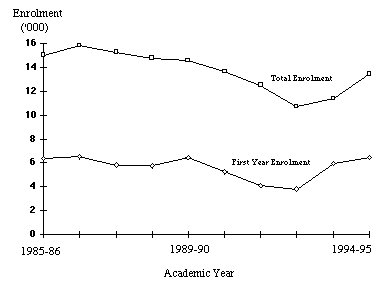Chapter 6: The Development of Higher Education
| 6.1 | Higher education in Hong Kong has existed for more than a century. The oldest current institution is the University of Hong Kong, founded in 1911, but it incorporated a College of Medicine which had been established in 1887. The Chinese University of Hong Kong was formed in 1963 by the amalgamation of three post-secondary colleges : New Asia (1949), Chung Chi (1951) and United (1956); a fourth college, Shaw College, was established in 1986. Hong Kong Baptist University was registered (as Baptist College) under the Post-Secondary College Ordinance in 1970, and Lingnan College was similarly registered in 1978, although it derives from Lingnan University in Guangzhou (1927). Shue Yan College was registered in 1976. The Hong Kong Polytechnic University was established (as the Hong Kong Polytechnic) in 1972 and both the City University of Hong Kong (as the City Polytechnic) and the Hong Kong Academy for Performing Arts in 1984. More recent higher education foundations include the Open Learning Institute of Hong Kong (1989), The Hong Kong University of Science and Technology (1991), the Hong Kong Technical Colleges at Chai Wan and Tsing Yi (1993) and the Hong Kong Institute of Education, established in September 1994 from four existing colleges of education and the Institute of Language in Education, previously under the Education Department. | ||||||
| 6.2 | The motives of those who provided the earliest higher education in Hong Kong were largely philanthropic, although there was sometimes an ideological bias. The founders wished to give the opportunity for higher education to young people, but in some cases hoped that the student would thereby acquire a view of the world to which they were sympathetic. The scale of provision, in terms of the population of Hong Kong, was very small. But gradually it became clear that Hong Kong's needs could not be met solely by private benefactors, and other sources of finance had to be found - principally government, but also employers and, in most cases, the students themselves. There has still, in more recent years, been an important place for donation in higher education, but in the provision of plant and amenity rather than in the mainstream of education itself. | ||||||
| 6.3 | The increasing demand for higher education, which changed it from a small scale and largely private activity to a major industry substantially supported by the Hong Kong taxpayer, occurred for a variety of reasons. Raising the school leaving age produced much larger cohorts of young people who had higher education as an attainable goal. The linking of academic qualifications with upward social mobility (long present in Chinese society) led to parental pressures for children to exploit the educational opportunities as far as possible. As Hong Kong industry and commerce moved from low-skilled, low-wage production towards more sophisticated markets and outputs, employers needed a better educated workforce, including increasing numbers at the highest level. Government itself, both because of its responsibility for meeting the aspirations and the needs of the people of Hong Kong and because of its own increasing requirement for well qualified personnel in such areas as the civil service, health and education, fuelled the demand. | ||||||
| 6.4 | The pressure for wider access to higher education was met in part by expanding existing institutions and in part by founding new ones. As well as providing increased opportunity for young adults, there has been major growth, through the OLI, the schools of continuing education in the universities and professional bodies, in the availability of higher education to older age groups. The largest recent impetus to growth, however, has been the government's decision in 1989 to expand access to full-time undergraduate education. In our Interim Report we gave a diagram showing the growth in the age participation rate for undergraduates (proportion of the 17-20 year old age group for whom first year first degree places were available) from 2% in the 1970s to 18% in 1994. That diagram is shown (updated and including the APA) as Figure 6.1. The total enrolment in the UGC institutions and the APA is given in Figure 6.2. In Figure 6.3, we show similar histories for entry to full-time sub-degree courses in the UGC institutions, the HKIEd, the APA and the Technical Colleges. We shall discuss this recent expansion more fully in Chapter 8. | ||||||
Figure 6.1 FYFD Enrolments (fte) in the | |||||||
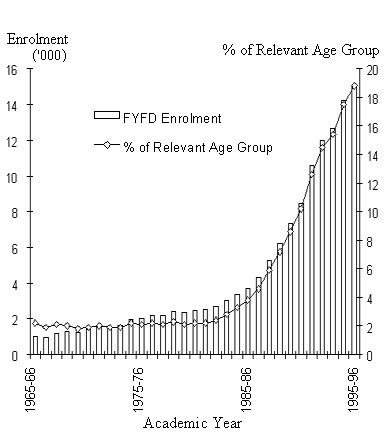 | |||||||
Source : UGC Secretariat and APA | |||||||
Figure 6.2 Total Enrolments (fte) in the | |||||||
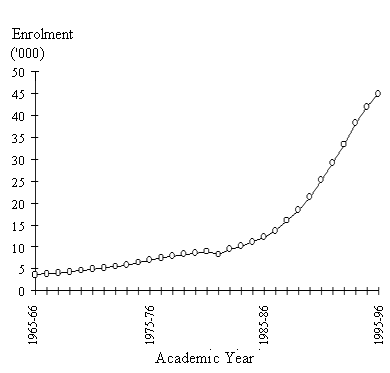 | |||||||
Source : UGC Secretariat and APA | |||||||
Figure 6.3 Full-time Sub-Degree Enrolments in the | |||||||
| |||||||
Source : UGC Secretariat and APA | |||||||
| 6.5 | The demand for qualifications beyond the first degree, or its equivalent, has been determined by considerations rather different from those on which entry to bachelor's or higher certificate or diploma courses is predicated. As far as taught master's programmes are concerned, the need has been either for specialist knowledge beyond the level of an undergraduate course (technology is a typical area) or for a broad conspectus of an occupational area not at the time covered in undergraduate syllabuses (the rise of the MBA is an example). Both employees and employers have an interest in taught master's courses: the growth in enrolment is shown for the last decade in Figure 6.4. | ||||||
Figure 6.4 Taught Postgraduate Students | |||||||
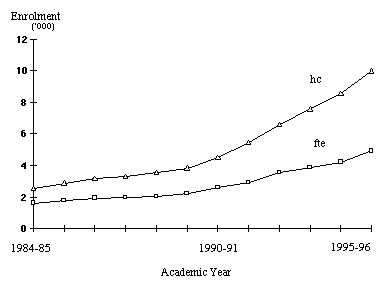 | |||||||
Source : UGC Secretariat | |||||||
| 6.6 | The numbers taking master's degrees or doctorates by research are to a large extent determined by the availability of support for the student. There have also been limitations imposed by the UGC for financial reasons associated with staff and facilities and because of the agreed role and mission of individual institutions. The number of research students is also clearly related to the number of staff willing and able to supervise them and until quite recently there had only been a limited "research culture" in Hong Kong's HEIs (in 1994-95 only 50% of the academic staff themselves held doctorates). Partly because the recent major expansion of the system has led to the recruitment of many new staff from outside Hong Kong, and partly because of financial encouragement by government and the establishment of the Research Grants Council to provide the mechanism for disbursement, that situation is changing. Research activity has recently grown very markedly (Figure 6.5) and so has the number of research students (Figure 6.6). | ||||||
Figure 6.5 Value of On-going Research Projects | |||||||
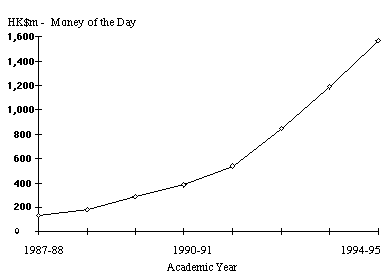 | |||||||
Source : UGC Secretariat | |||||||
Figure 6.6 Research Students in the UGC-funded Institutions (1988/89 - 1995/96) | |||||||
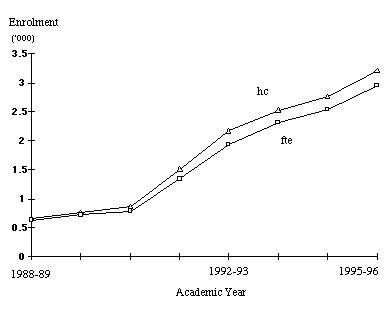 | |||||||
| |||||||
| 6.7 | Hong Kong was, in fact, remarkably reluctant to become involved in research. The issue was debated in the 1970s, when Taiwan, South Korea and Singapore were planning to upgrade their industrial technologies, but the Advisory Committee on Diversification (set up in 1977 and reporting in 1979) did not favour government expenditure on research and development (R&D;). The UGC (then UPGC), however, became increasingly worried about the difficulty of attracting good staff to the expanding tertiary system unless research facilities could be provided. It set up its own enquiry under the chairmanship of the then Rector of Imperial College, which reported in 1983 and proposed the establishment of a Research Grants Committee which would distribute government support for research on a competitive basis. The Hong Kong Government rejected this proposal (or at any rate put it into cold storage), it is believed because officials regarded university research as potentially very costly and also felt that private industry would unaided make the right decisions about R&D; in market terms. With hindsight this may have been an expensive misjudgement : the extraordinary success of the Taiwan electronics industry in the 1980s is said to be in part due to a symbiosis of public and private R&D.; In spite of this rebuff, the UGC continued to press upon government the importance of research and finally in 1991 the Research Grants Council was established. We describe its activities in paragraph 13.6. | ||||||
| 6.8 | Although university extramural departments have provided short courses for adults of all ages for many decades, these have mainly been related to cultural or leisure interests and the number of participants has been fairly small. The demand for continuing and professional education and qualification related to the workplace is generally more recent. The Hong Kong Management Association (founded 1960) first began putting its courses on a systematic credit-accumulating basis in 1985. As noted in paragraph 6.1, the OLI was founded in 1989. The extramural departments of the University of Hong Kong and the Chinese University of Hong Kong changed their names to the School of Professional and Continuing Education (SPACE) and the School of Continuing Studies (SCS) in 1992 and 1994 respectively. Quantifying the growth of continuing studies is difficult, partly because of problems of comparability of data and level, and partly because of unawareness of in-house activity. In Fig 6.7 we chart the growth in continuing education numbers in five UGC institutions, but this probably represents only about half of the total (see paragraphs 12.7 and 24.1). | ||||||
Figure 6.7 Growth in Continuing Studies (Headcount) | |||||||
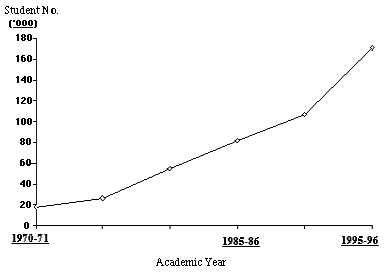 | |||||||
Source : CityU, HKBU, CUHK, PolyU and HKU | |||||||
| 6.9 | Accompanying the long term development of higher education which we have described in the preceding paragraphs, there has been a corresponding growth in capital provision - buildings, equipment, libraries - and in recurrent funding. Most of the latter is associated with staffing - academics, administrators and ancillary grades of many different kinds. Higher education has become a major industry and an important employer in Hong Kong. We show in Figure 6.8 the increase in government expenditure on higher education as a percentage of GDP and also that percentage divided by the age participation rate. The decline in the latter figure suggests that the taxpayer has been getting increasingly good value from the HE system. In Figure 6.9 we give the growth in number employed as a percentage of the working population. | ||||||
Figure 6.8 Government Expenditure on Higher Education | |||||||
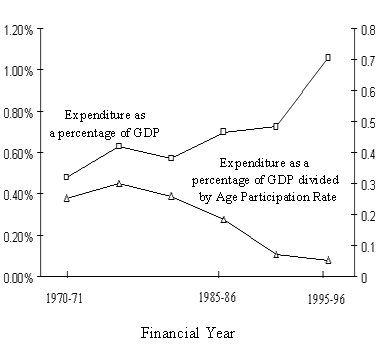 | |||||||
| |||||||
Figure 6.9 Full-time Staff Number in the UGC-funded Institutions, | |||||||
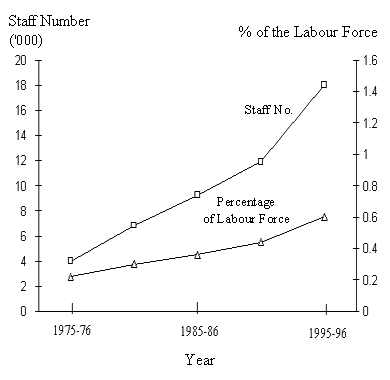 | |||||||
| |||||||
| 6.10 | Higher education in Hong Kong has throughout its history made a dynamic and changing contribution to the needs of the people and the economy. The growth in participation which we have charted will in the long run almost certainly continue and two major purposes of this report are to take stock of the present position and to offer suggestions as to the directions in which future development might be encouraged. Before we turn to those, however, it will be useful to examine in more detail the structural changes in, and expansion of, higher education during the recent past. | ||||||
